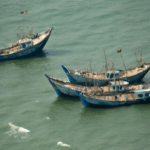Overexploitation is a concerning issue that has detrimental effects on natural resources and ecosystems. It arises from a variety of causes, including population growth and increased demands for resources. As human populations expand, there is a higher demand for food, water, energy, and other essential resources. This leads to excessive extraction and depletion of natural resources beyond their sustainable yield. Additionally, economic factors such as profit-driven industries, inadequate regulatory policies, and limited enforcement contribute to overexploitation. Climate change and environmental degradation further exacerbate the problem, disrupting ecosystems and reducing the resilience of natural resources. Addressing these causes of overexploitation requires awareness, sustainable management practices, and effective governance.
Overexploitation, also known as overharvesting, refers to the unsustainable extraction or utilization of natural resources beyond their capacity for replenishment. This practice has significant adverse impacts on ecosystems and can lead to the depletion or extinction of various species and ecosystems. There are several causes of overexploitation:
1. Overpopulation: The exponential growth of human population puts immense pressure on natural resources by increasing the demand for food, water, energy, and other essential commodities.
2. Demand for resources: The rising demand for products derived from natural resources, such as timber, oil, minerals, and wildlife products, drives overexploitation. Development and industrialization further fuel this demand.
3. Lack of property rights or regulations: In areas with weak governance or poorly defined property rights, there is often a lack of regulations or enforcement. This creates an environment where resources are overused and exploited without consideration for sustainability.
4. Poverty and lack of alternatives: In many developing countries, poverty and limited economic opportunities force communities to rely heavily on natural resources for their livelihoods. This can lead to unsustainable exploitation as people prioritize immediate survival over long-term sustainability.
5. Technological advancements: Advances in technology have increased the efficiency and capacity of resource extraction, making it easier to exploit resources at an unsustainable rate. Improved fishing techniques, mechanized logging, and extraction technologies contribute to overexploitation.
6. Climate change: Climate change has altered ecosystems and affected natural resource availability. As some resources become scarcer, there is a higher likelihood of overexploitation as people strive to meet their needs in a changing environment.
7. Lack of awareness and education: Inadequate knowledge or understanding of sustainable resource management practices can lead to overexploitation. Without proper education and awareness, people may not realize the consequences of their actions or alternatives to unsustainable practices.
Understanding the causes of overexploitation is crucial for implementing effective conservation efforts and sustainable resource management. By addressing these root causes, it is possible to mitigate the negative impacts on ecosystems and foster a more sustainable relationship with our natural resources.
Overfishing
Overfishing is a significant issue that impacts the health of our oceans and poses a threat to global fisheries. It occurs when fish are captured at a rate that exceeds their ability to reproduce and replenish their populations. This unsustainable fishing practice has been driven by various factors and has far-reaching consequences on the ecosystem and communities worldwide.
One of the main causes of overfishing is the increasing demand for seafood. As the global population continues to grow, the demand for fish as a source of protein has risen dramatically. Industrial fishing methods, such as trawlers and purse seiners, have allowed for massive catches to meet this demand. However, these methods often result in the capture of not only target species but also non-target species known as by-catch. This indiscriminate fishing exacerbates the problem of overfishing by depleting populations of non-target species, including dolphins, turtles, and sharks.
Additionally, the lack of effective fisheries management contributes to overfishing. In many parts of the world, there are limited regulations and enforcement mechanisms to control fishing activities. Some countries have weak or outdated fisheries policies, allowing for excessive fishing effort without considering the long-term consequences. The absence of proper monitoring and control mechanisms leads to illegal, unreported, and unregulated fishing, commonly known as IUU fishing, which further intensifies overfishing.
Another factor that drives overfishing is the use of destructive fishing practices. Certain fishing techniques, such as bottom trawling and dynamite fishing, cause immense damage to marine habitats, including coral reefs and seafloor ecosystems. These practices not only deplete target fish populations but also result in the destruction of essential habitats for other marine species. The loss of biodiversity and the collapse of ecosystems have severe ecological consequences, disrupting the balance of marine life.
Overfishing also has profound socio-economic impacts. It threatens the livelihoods of millions of people worldwide, especially in developing coastal communities heavily reliant on fishing for income and sustenance. When fish populations decline, fishers face reduced catches, declining incomes, and even unemployment. Consequently, this creates social and economic instability within these communities, leading to poverty and food insecurity. Moreover, the decline of fish stocks can affect local economies that depend on the fishing industry, including processing plants and seafood markets.
Addressing overfishing requires collective action from governments, fisheries management organizations, and consumers. Implementing sustainable fishing practices, such as setting catch limits, enforcing quotas, and using selective fishing gear, is crucial to allow fish populations to recover and restore the balance in marine ecosystems. Improved monitoring and control measures, including satellite technology and increased surveillance, can help combat IUU fishing effectively.
Moreover, promoting alternative sources of protein, such as plant-based alternatives, can reduce the demand for seafood and alleviate pressure on fish stocks. Consumer awareness and education about sustainable fishing practices and responsible seafood consumption also play an essential role in driving change and supporting sustainable fisheries.
Overall, overfishing is a complex issue with multiple causes and far-reaching consequences. It is imperative that concerted efforts are made to implement sustainable fishing practices, strengthen fisheries management, and ensure the health and resilience of our oceans for current and future generations.
Deforestation
Deforestation refers to the deliberate or large-scale removal of forests or the conversion of forested land into non-forest areas. This practice is a significant cause of overexploitation around the world. Deforestation has both immediate and long-term impacts on the environment, society, and economy.
One of the primary reasons for deforestation is the clearing of land for agricultural purposes. As the global population continues to grow, there is an increasing demand for food production. As a result, vast areas of forests are cleared to make way for the cultivation of crops or the rearing of livestock. This agricultural expansion not only leads to the loss of precious habitats but also brings about a decline in biodiversity.
Additionally, industries such as logging and mining contribute to deforestation. The timber industry, in particular, is one of the major culprits behind forest destruction. Trees are indiscriminately felled for commercial purposes, including the production of paper, furniture, and construction materials. Moreover, mines often require the clearing of forests to access mineral resources beneath the ground, leading to permanent loss of land cover.
Deforestation also occurs due to infrastructure development projects, such as road construction and urbanization. As human settlements expand, the need for transportation networks and residential areas also increases. This results in the clearance of large forested areas to build roads, houses, and infrastructure. The rapid urbanization often takes place at the expense of natural habitats and creates ecological imbalances.
The consequences of deforestation are far-reaching. Forests play a vital role in regulating the climate by absorbing carbon dioxide, a greenhouse gas responsible for global warming. With fewer trees, the capacity to capture and store carbon diminishes, contributing to climate change. Moreover, deforestation disrupts the water cycle, leading to altered rainfall patterns, decreased soil fertility, and increased erosion.
The loss of forests also poses a threat to countless plant and animal species. Forests are home to a significant portion of Earth’s biodiversity, providing habitats for numerous species. The destruction of these habitats disrupts ecosystems and can even lead to the extinction of plant and animal species.
Furthermore, deforestation has detrimental effects on indigenous communities and local populations who depend on forests for their livelihoods, cultural practices, and traditional knowledge. These communities often face displacement and economic hardships as their natural resources are depleted or destroyed.
Efforts to combat deforestation include reforestation initiatives, sustainable land management practices, and the promotion of alternative livelihoods. Various organizations and governments have introduced measures to protect and restore forests, impose stricter regulations on logging, and raise awareness about the importance of forest preservation.
In conclusion, deforestation is a critical cause of overexploitation. It stems from agricultural expansion, logging and mining activities, and infrastructure development, leading to severe environmental, social, and economic consequences. The preservation and sustainable management of forests are crucial in ensuring a balanced and sustainable future for our planet.
Illegal wildlife trade
Illegal wildlife trade refers to the illegal buying, selling, and trafficking of various animal species and their products. It is considered one of the major causes of overexploitation. This illicit trade includes a wide range of activities involving live animals as well as their body parts, such as skins, bones, horns, tusks, and even exotic plants.
The scale of illegal wildlife trade is alarming, with estimates suggesting that it is worth billions of dollars globally. Not only does it pose a significant threat to biodiversity and ecosystem balance, but it also undermines the rule of law and fuels organized crime. This illicit activity has detrimental consequences for both wildlife populations and the communities that depend on them.
One primary driver of illegal wildlife trade is the demand for exotic pets. Rare and endangered animals like parrots, turtles, and monkeys are captured in the wild and sold as pets in the illegal market. It is estimated that for every one animal that survives being captured and transported, numerous others die during the process. This trade not only depletes populations of these species but also affects their genetic diversity and disrupts ecosystems.
Another significant aspect of illegal wildlife trade is the hunting and trafficking of animals for their body parts. This includes products derived from iconic species such as elephants, rhinos, and tigers. Elephants are targets for their ivory tusks, rhinos for their horns, and tigers for their bones and skins. Despite international bans and strict wildlife protection laws, the demand for these products persists due to their perceived cultural, medicinal, and status value. As a result, poachers and organized criminal networks engage in illegal hunting and smuggling.
The illegal trade in wildlife products also extends to plants. Exotic and rare plants, including orchids, cacti, and medicinal herbs, are being trafficked for their ornamental value, medicinal properties, or horticultural appeal. Unsustainable collection impacts natural habitats, disrupts ecosystems, and affects plant populations, resulting in a decline in biodiversity.
To combat illegal wildlife trade, international efforts have been focused on strengthening legislation, improving enforcement, and raising awareness. Internationally recognized conventions, such as the Convention on International Trade in Endangered Species of Wild Fauna and Flora (CITES), aim to regulate and control the trade of endangered species and their products.
Furthermore, local communities play a crucial role in combatting illegal wildlife trade. By empowering and involving them in conservation efforts, sustainable alternatives to illegal activities can be promoted, ensuring the protection and preservation of both wildlife and their habitats.
In conclusion, illegal wildlife trade is a significant driver of overexploitation, posing a severe threat to wildlife populations and ecosystems. The demand for exotic pets, animal body parts, and rare plants fuels this illicit trade. It is necessary to strengthen enforcement, raise awareness, and support local communities to combat this illegal activity effectively.
Industrial agriculture
Industrial agriculture, also known as intensive agriculture or factory farming, is a method of large-scale farming that uses advanced technologies, machinery, and chemicals to maximize production efficiency and yield. This approach to farming has become increasingly prevalent over the last century, transforming the agricultural sector and substantially impacting both the environment and society.
One primary aspect of industrial agriculture is the mechanization of farming processes. Heavy machinery, such as tractors, combines, and harvesters, are employed to carry out tasks like planting, harvesting, and processing crops. This mechanization allows for increased speed and scale of production, enabling farmers to cultivate larger areas of land and achieve higher crop yields.
To enhance productivity, industrial agriculture relies heavily on the use of synthetic fertilizers, pesticides, and herbicides. Chemical fertilizers provide essential nutrients to the soil, compensating for nutrient depletion due to repetitive and intensive cropping practices. However, the excessive use of synthetic fertilizers can result in environmental problems like soil degradation, water pollution, and the loss of biodiversity.
Furthermore, industrial agriculture heavily depends on the use of pesticides and herbicides to control pests and weeds, respectively. While these chemicals can effectively protect crops, they also pose risks to the environment and human health. Pesticides can contaminate water bodies and soil, affecting non-target organisms and disrupting ecosystems. Additionally, the exposure to pesticides has been linked to various health issues in farmworkers and can even find its way into the food chain, potentially affecting consumers.
Another characteristic of industrial agriculture is the practice of monocropping or growing only a single crop species on a large scale. This specialization allows for streamlined production processes and facilitates management but carries certain drawbacks. Monocultures are vulnerable to diseases and pests, leading to an increased reliance on pesticides. Moreover, the loss of biodiversity associated with monocropping can disrupt ecosystems and make agricultural systems more susceptible to environmental changes.
The expansion of industrial agriculture has led to the consolidation and concentration of farmland into the hands of a few large-scale corporations. This trend has implications for small-scale farmers, who often struggle to compete with the economies of scale enjoyed by industrial agricultural operations. It also contributes to the homogenization of agricultural landscapes, diminishing local diversity and cultural heritage.
In summary, industrial agriculture has revolutionized the way food is produced, enabling higher productivity and efficiency. However, the intensive use of machinery, synthetic fertilizers, pesticides, and monocropping practices associated with this method of farming have negative environmental and social consequences. Finding a balance between food production and sustainable practices is crucial to mitigate the adverse impacts of industrial agriculture.
Mining
Mining is an activity that involves the extraction of minerals and other valuable resources from the earth’s crust. It plays a significant role in various industries, including construction, manufacturing, and energy production. However, the process of mining can have severe environmental and social consequences, often leading to overexploitation of natural resources. This section explores the causes and impacts of mining, shedding light on the reasons behind its contribution to overexploitation.
First and foremost, the demand for minerals and resources is a primary driver of mining activities. With the expanding global population and industrial development, the need for these resources continues to grow exponentially. This ever-increasing demand puts tremendous pressure on mining companies to extract more minerals, resulting in overexploitation of available deposits.
Moreover, technological advancements have made it easier to explore and access previously inaccessible mining sites. This has led to the expansion of mining operations into remote and fragile ecosystems, such as rainforests, mountains, and deep-sea areas. These ecosystems often host unique biodiversity and are more vulnerable to the impacts of mining activities.
One of the most significant impacts of mining is habitat destruction and loss of biodiversity. The extraction of minerals requires the clearing of vegetation and the removal of topsoil, leading to the loss of critical habitats for many species. The disruption of ecosystems through mining can result in the extinction or displacement of indigenous flora and fauna, disrupting the delicate balance of ecosystems and their ecological services.
Another detrimental consequence of mining is water pollution. The extraction and processing of minerals often involve the use of large quantities of water, which can become contaminated with hazardous chemicals and heavy metals. These pollutants can find their way into rivers, lakes, and groundwater, affecting both aquatic organisms and human communities that rely on these water sources.
Furthermore, mining activities can cause soil erosion and land degradation. The removal of vegetation and topsoil destabilizes the land, increasing the risk of landslides and soil erosion. As a result, valuable agricultural land becomes less productive, affecting local communities’ food security and livelihoods.
Mining operations also generate significant amounts of waste, including toxic tailings and mine waste rock. Improper storage and management of these wastes can lead to further pollution of water sources and soil, posing long-term risks to both human health and the environment.
Additionally, mining can have social and cultural impacts. Local communities often bear the burden of mining activities, experiencing displacement, loss of traditional livelihoods, and social disruption. The presence of mines can lead to conflicts over land rights, as well as the exploitation of labor, especially in countries with weak regulatory frameworks.
In conclusion, mining is a major contributor to overexploitation due to the increasing demand for minerals and resources, technological advancements that facilitate access to previously untouched areas, and the significant environmental and social impacts it generates. Efforts to mitigate these effects must focus on sustainable mining practices, such as minimizing habitat destruction, properly managing waste, and involving local communities in decision-making processes.
External Links
- Overexploitation Definition & Examples – Video & Lesson Transcript …
- Consequences Of Overexploitation Of Natural Resources | Eco Jungle
- Causes, Effects and Solution of Depletion of Natural Resources …
- Overexploitation – an overview | ScienceDirect Topics
- What is Overfishing? Facts, Effects and Overfishing Solutions












